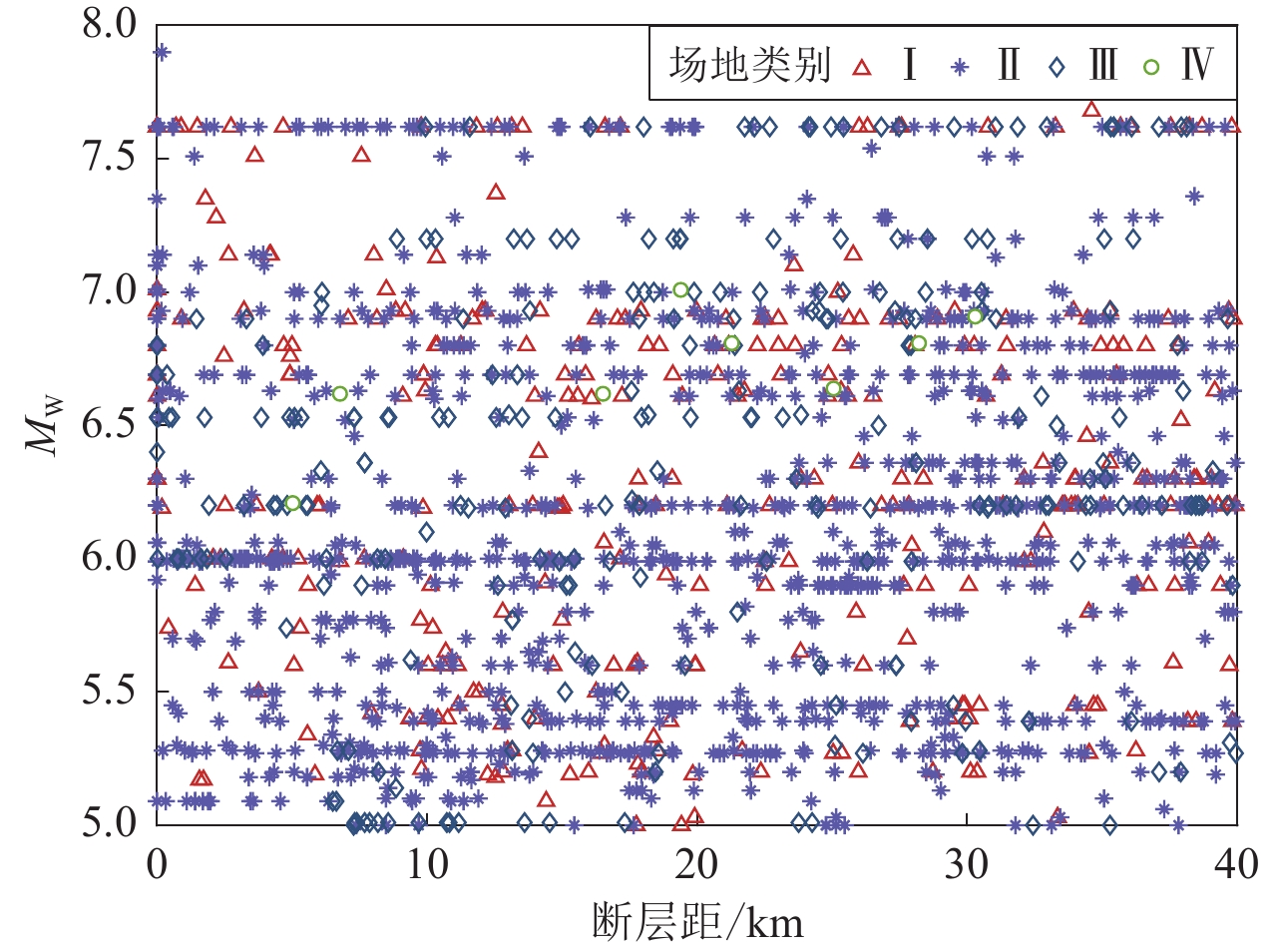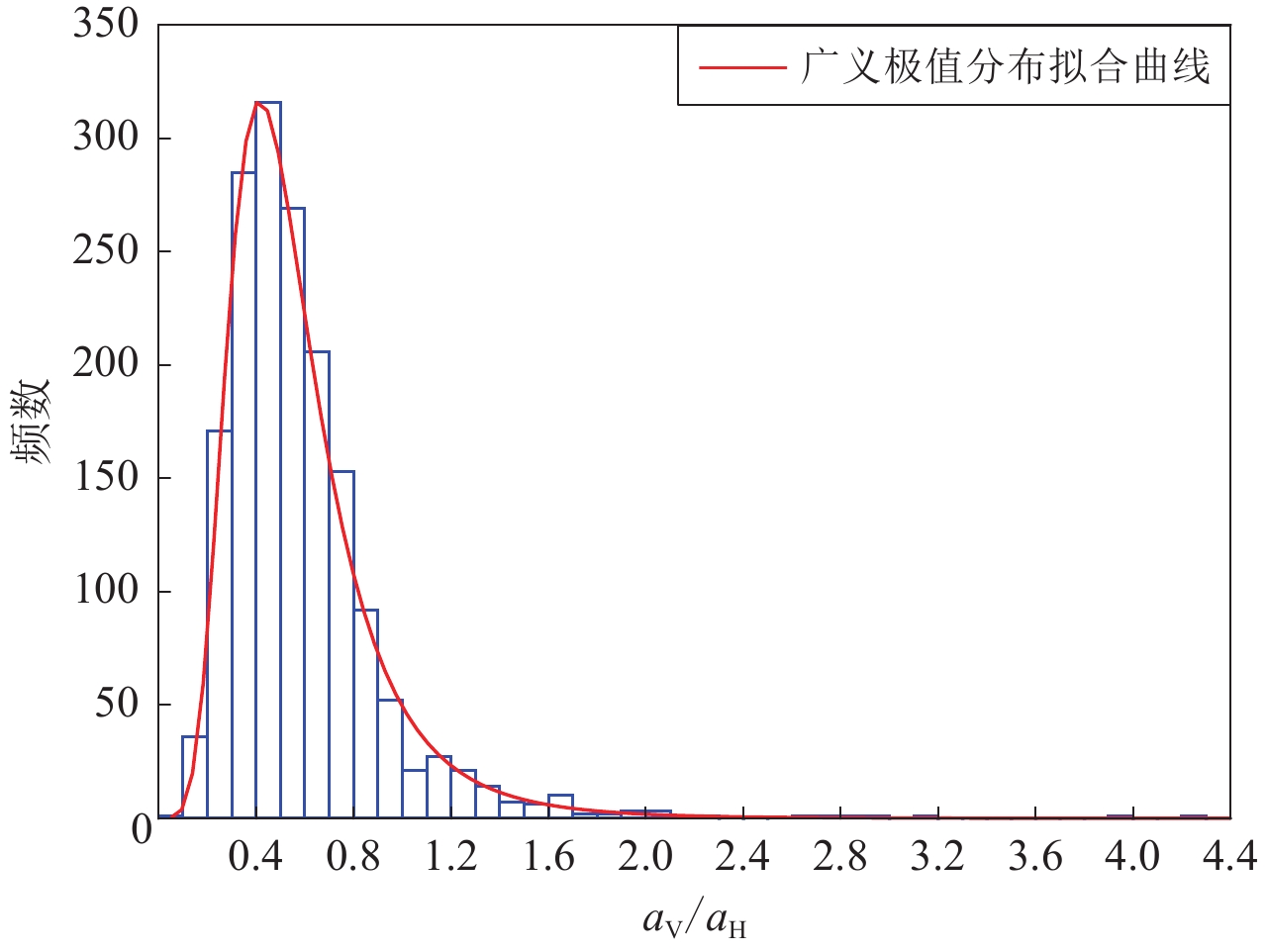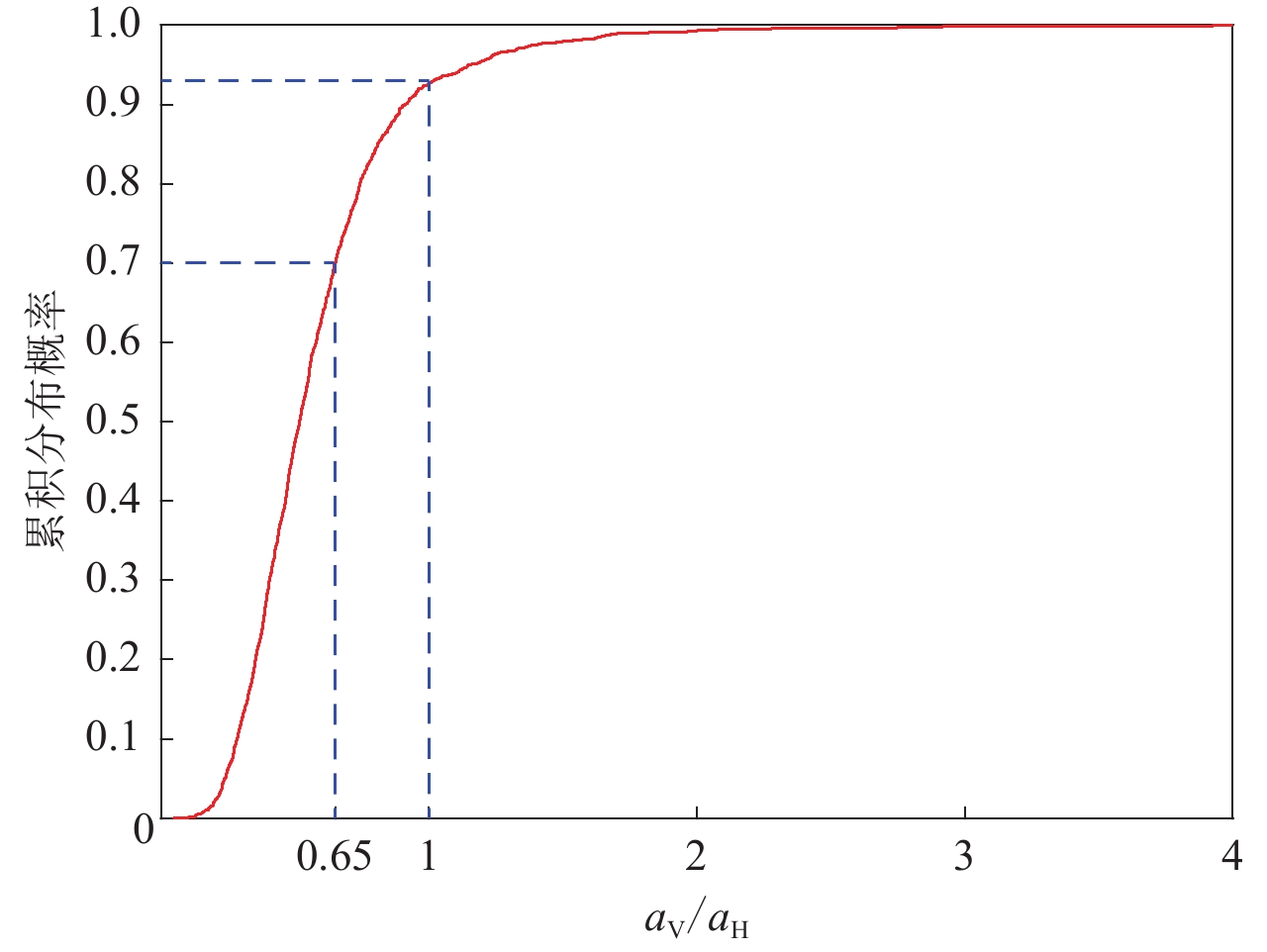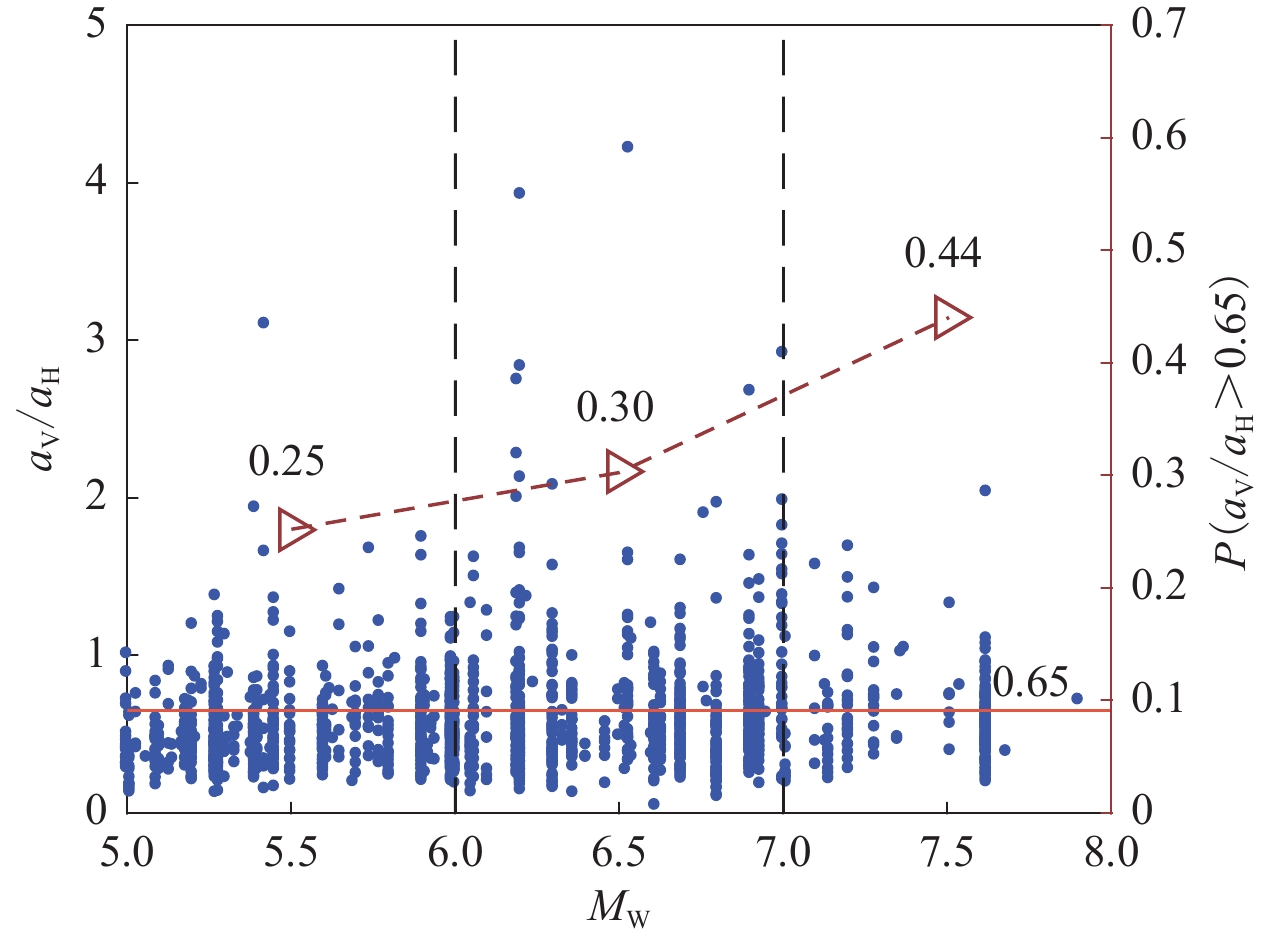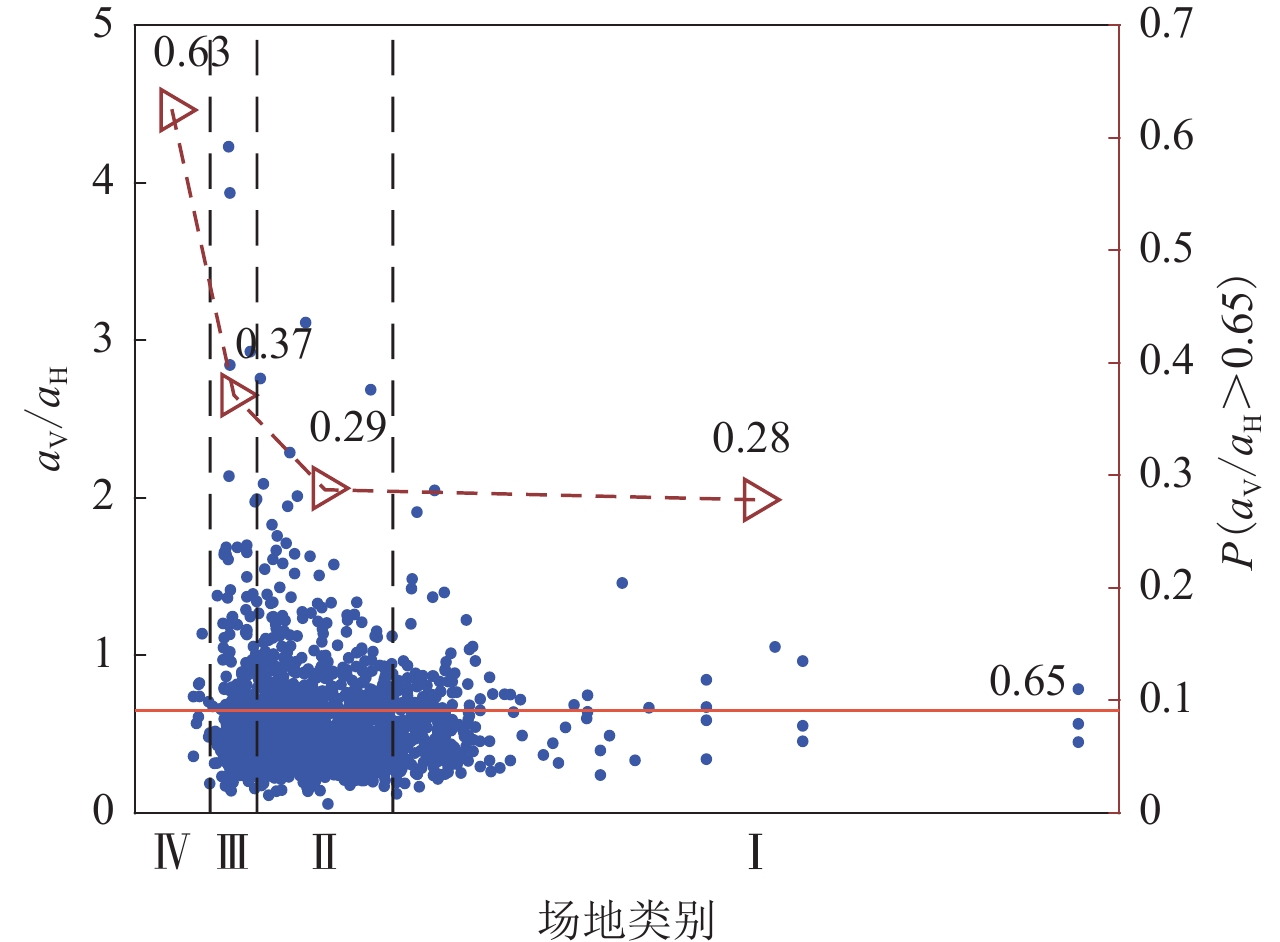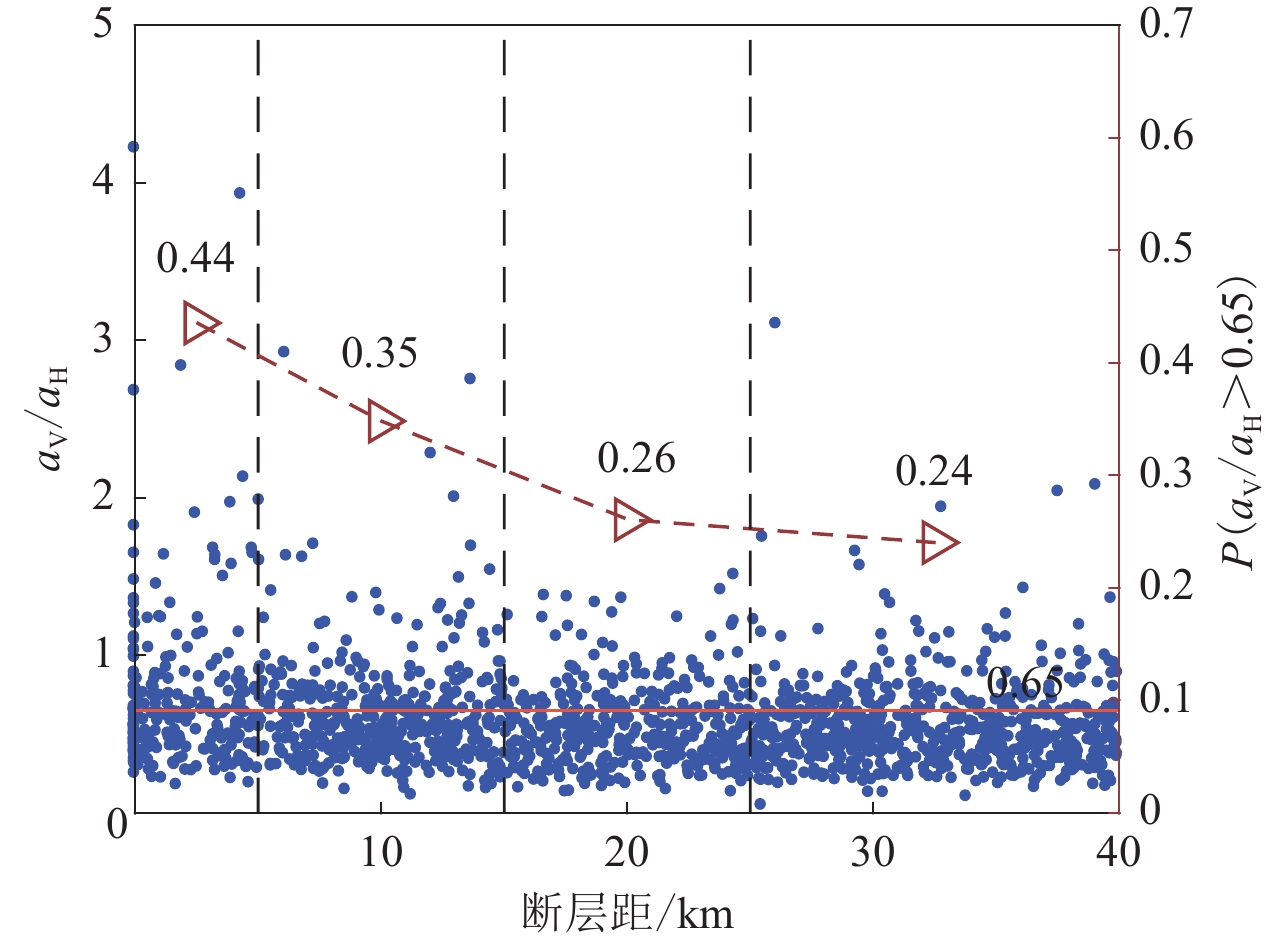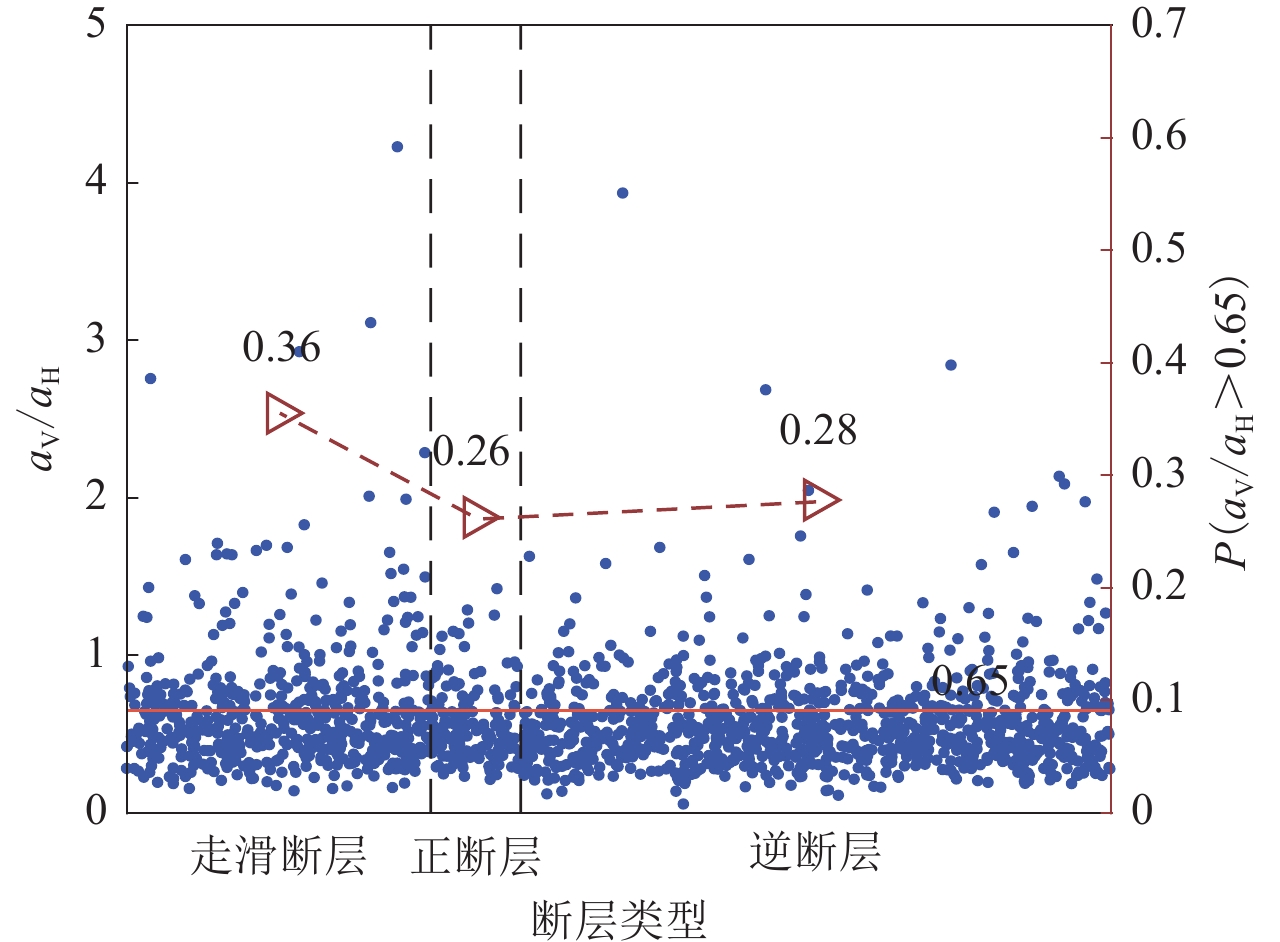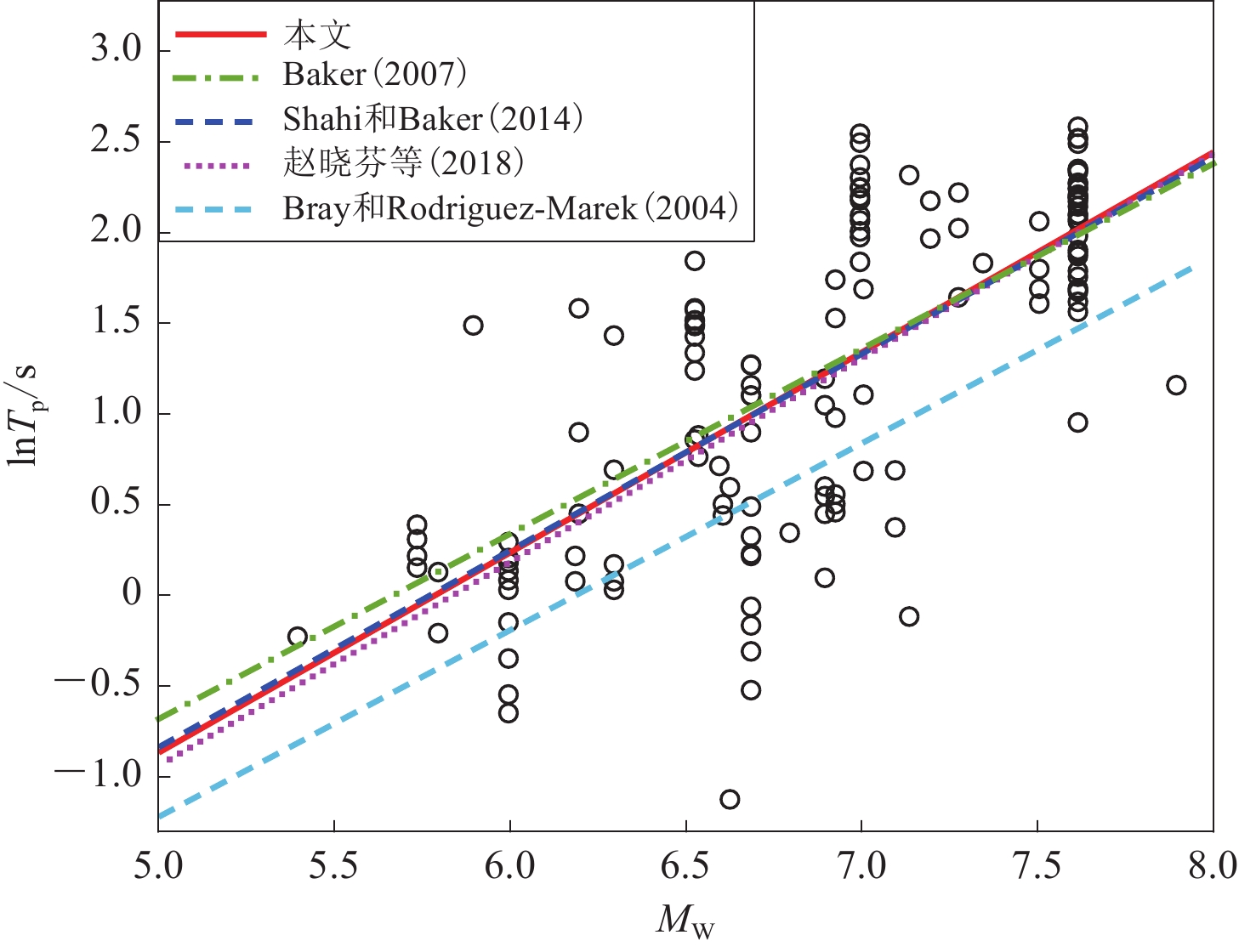Statistical analysis of near-fault ground motion acceleration peak ratio and pulse characteristics
-
摘要:
为进一步了解近断层地震动的显著竖向特性和速度脉冲特性,基于NGA-West2强地面运动数据库选取1 706组强地震动记录,研究了竖向与水平向加速度峰值比aV/aH的总体分布特征,并探讨了aV/aH随矩震级MW、断层距Rjb、场地类别和断层类型变化的规律。在此基础上,通过Baker脉冲识别方法选取出140组近断层速度脉冲地震动,并提取出每条地震动记录的脉冲周期Tp和速度脉冲峰值PGVp,研究其脉冲参数随矩震级MW和断层距Rjb变化的统计规律及经验模型。结果表明:近断层加速度峰值比aV/aH与地震动参数密切相关,其概率分布呈极值Ⅱ型分布;脉冲周期Tp随矩震级的增大而增大,与场地条件的相关性较弱,脉冲周期Tp经验模型与Shahi和Baker 模型在大震级范围内的差异小,且差异随矩震级的增大而减小,说明可忽略是否区分脉冲类型对脉冲周期随矩震级的定量关系的影响;速度脉冲峰值PGVp的大幅值主要出现在大震区和毗邻发震断层区域。
Abstract:To further understand the significant vertical characteristics and velocity pulse characteristics of near-fault ground motions, a comprehensive study was conducted using 1 706 sets of strong ground motion records selected from the NGA-West2 database. This study aimed to investigate the overall distribution patterns of the vertical-to-horizontal acceleration peak ratio, designated as aV/aH, and to explore how this ratio varies with various ground motion parameters such as moment magnitude MW, fault distance Rjb, site type, and fault type. Additionally, the study employed the multi-component velocity pulse identification method to obtain crucial pulse parameters, including the pulse period (Tp) and velocity pulse peak (PGVp), for 140 groups of near-fault velocity pulse ground motions. The statistical patterns and empirical models were then established to assess the relationship between these pulse parameters and the moment magnitude, as well as the fault distance. The results revealed several intriguing insights. Firstly, it was observed that the near-fault acceleration peak ratio aV/aH exhibits a strong correlation with ground motion parameters. The probability distribution of aV/aH follows Frechet distribution, indicating that the occurrence of high aV/aH ratios is not random but rather follows a specific pattern. This finding indicates that the vertical characteristics of ground motion may be significant in the near-fault regions, especially under certain seismic conditions. In addition, it is also found that the aV/aH ratio tends to increase with moment magnitude increasing and fault distance decreasing, indicating that the ground motion with larger vertical acceleration is more likely to occur. Additionally, the study also observed that smaller equivalent shear wave velocities vS30 and fault types such as strike-slip and reverse faults are associated with a higher likelihood of generating larger aV/aH ratios. These findings highlight the importance of considering vertical ground motion in seismic hazard assessments and earthquake engineering design, especially in areas with these specific ground motion characteristics. The study also focused on the pulse characteristics of near-fault ground motions. The analysis revealed that the pulse period increases with moment magnitude increasing, while the correlation with site conditions is relatively weak. This suggests that the pulse period is primarily influenced by the magnitude of the earthquake rather than local site conditions. Furthermore, a comparison of the empirical model of pulse period with the model proposed by Shahi and Baker revealed that the two models exhibit minimal differences in the range of large magnitudes. More importantly, the difference between the two models decreases as the moment magnitude increases, indicating that whether or not to distinguish between different pulse types has a negligible impact on the quantitative relationship between pulse period and moment magnitude. This finding suggests that the empirical model for pulse period can be reliably used to predict pulse periods in near-fault regions, regardless of the specific pulse type. Finally, the study found that the largest amplitudes of velocity pulse peaks primarily appear in regions with high magnitude earthquakes and in proximity to the seismogenic fault. This observation underscores the significance of vertical ground motion in these areas, particularly during large earthquakes. It also highlights the need for enhancing seismic hazard assessments and engineering designs that specifically address the vertical component of ground motion in these high-risk regions. In summary, this comprehensive study provides valuable insights into the significant vertical and pulse characteristics of near-fault ground motion. The findings emphasize the importance of considering earthquake magnitude, fault distance, site conditions, and fault type in assessing the potential for extreme vertical ground motion and quantifying the key parameters of near-fault velocity pulses. These results not only enrich our understanding of the complex behavior of near-fault ground motion, but also provide essential guidance for earthquake engineers and researchers in refining seismic hazard assessments, designing earthquake-resistant structures, and developing effective risk mitigation strategies. The study underscores the necessity of incorporating these nuanced ground motion characteristics into future seismic design codes and guidelines so as to ensure the safety and recoverability of the near-fault area.
-
-
表 1 我国建筑抗震设计规范场地类别与NGA-West2中vS30的对应关系
Table 1 The corresponding relationship between standard site categories in the code for seismic design of building China and vS30 in NGA-West2
场地类别 vS30/(km·s−1) Ⅳ <160 Ⅲ 160—260 Ⅱ 260—550 Ⅰ(Ⅰ 0, Ⅰ 1) >550 表 2 加速度峰值比aV/aH的区间划分及频数分布表
Table 2 Interval division and frequency distribution of acceleration peak ratio aV/aH
区间 (0,0.2$ ] $ (0.2,0.4$ ] $ (0.4,0.6$ ] $ (0.6,0.8$ ] $ (0.8,1.0$ ] $ (1.0,1.2$ ] $ (1.2,1.4$ ] $ (1.4,1.6$ ] $ (1.6,1.8$ ] $ (1.8,4.4$ ] $ 频数 37 456 585 359 144 48 35 13 12 17 表 3 加速度峰值比aV/aH的累积分布概率
Table 3 Cumulative distribution probability of acceleration peak ratio aV/aH
aV/aH ≤0.2 ≤0.4 ≤0.65 ≤0.8 ≤1.0 ≤1.2 ≤1.6 ≤2.0 ≤3.0 ≤4.4 累积概率 2.2% 28.9% 69.9% 84.2% 92.7% 95.5% 98.3% 99.4% 99.8% 100% 表 4 不同矩震级MW范围内加速度峰值比aV/aH的统计特征参数
Table 4 Statistical characteristic parameters of ground acceleration peak ratio aV/aH within different moment magnitude ranges
MW 地震动记录数 aV/aH最大值 aV/aH平均值 aV/aH标准差 aV/aH变异系数 P(aV/aH>0.65) 5.0—6.0 695 3.10 0.54 0.26 0.48 0.25 6.0—7.0 784 4.22 0.60 0.37 0.63 0.30 7.0—8.0 227 2.92 0.67 0.37 0.55 0.44 表 5 不同场地类别下加速度峰值比aV/aH的统计特征参数
Table 5 Statistical characteristic parameters of peak acceleration ratio aV/aH under different site categories
场地类别 地震动记录数 aV/aH最大值 aV/aH平均值 aV/aH标准差 aV/aH变异系数 P(aV/aH>0.65) Ⅰ (vS30>550 m/s) 316 2.04 0.55 0.25 0.46 0.28 Ⅱ (vS30=260—550 m/s) 1129 3.10 0.57 0.30 0.53 0.29 Ⅲ (vS30=160—260 m/s) 253 4.22 0.67 0.51 0.75 0.37 Ⅳ (vS30<160 m/s) 8 1.13 0.71 0.23 0.32 0.63 表 6 不同断层距下加速度峰值比aV/aH的统计特征参数
Table 6 Statistical characteristic parameters of acceleration peak ratio aV/aH with different fault distances
断层距/km 地震动记录数 aV/aH最大值 aV/aH平均值 aV/aH标准差 aV/aH变异系数 P(aV/aH>0.65) 0—5 241 4.22 0.72 0.51 0.70 0.44 5—15 442 2.92 0.61 0.33 0.54 0.35 15—25 395 1.51 0.54 0.25 0.46 0.26 25—40 628 3.10 0.54 0.28 0.52 0.24 表 7 不同断层类型下加速度峰值比aV/aH的统计特征参数
Table 7 Statistical characteristic parameters of acceleration peak ratio aV/aH for different types of faults
断层类型 地震动记录数 aV/aH最大值 aV/aH平均值 aV/aH标准差 aV/aH变异系数 P(aV/aH>0.65) 走滑断层 526 4.22 0.63 0.40 0.63 0.36 正断层 156 1.41 0.56 0.23 0.42 0.26 逆断层 1024 3.93 0.56 0.31 0.55 0.28 表 8 脉冲参数与地震动参数的相关性
Table 8 Correlation between pulse parameters and ground motion parameters
$ {\rho _{xy}} $ MW Rjb vS30 PGVp Tp MW 1.00 0.21 0.21 0.20 0.72 Rjb 1.00 −0.10 −0.38 0.27 vS30 1.00 −0.05 −0.07 PGVp 对称 1.00 0.11 Tp 1.00 注:$ {\rho _{xy}} $为皮尔森相关系数,Rjb为断层距,vS30为30 m场地覆盖土层等效剪切波速,PGVp为速度脉冲峰值,Tp为脉冲周期。 表 9 脉冲周期Tp随矩震级MW变化的经验模型对比
Table 9 Comparison of empirical models of pulse period Tp changing with moment magnitude MW
模型来源 经验模型关系式 脉冲分量 脉冲类型 Bray和Rodriguez-Marek (2 004) $ \ln {T_{\mathrm{p}}} = 1.03{M_{\mathrm{W}}} $−6.37 垂直或平行断层分量 不区分 Baker (2 007) $ \ln {T_{\mathrm{p}}} = 1.02{M_{\mathrm{W}}} $−5.78 垂直或平行断层分量 不区分 Shahi和Baker (2 014) $ \ln {T_{\mathrm{p}}} = 1.084{M_{\mathrm{W}}}$−6.256 最强速度脉冲分量 方向性效应脉冲 赵晓芬等(2 018) $ \ln {T_{\mathrm{p}}} = 1.123{M_{\mathrm{W}}} $−6.548 最强速度脉冲分量 不区分 本文 $ \ln {T_{\mathrm{p}}} = 1.103{M_{\mathrm{W}}} $−6.381 最强速度脉冲分量 不区分 -
韩建平,周伟. 2012. 汶川地震竖向地震动特征初步分析[J]. 工程力学,29(12):211–219. doi: 10.6052/j.issn.1000-4750.2011.05.0272 Han J P,Zhou W. 2012. Preliminary investigation on characteristics of vertical ground motion during Wenchuan earthquake[J]. Engineering Mechanics,29(12):211–219 (in Chinese).
贾俊峰,杜修力,韩强. 2015. 近断层地震动特征及其对工程结构影响的研究进展[J]. 建筑结构学报,36(1):1–12. Jia J F,Du X L,Han Q. 2015. A state-of-the-art review of near-fault earthquake ground motion characteristics and effects on engineering structures[J]. Journal of Building Structures,36(1):1–12 (in Chinese).
李宁,刘洪国,刘平,李忠献,谢礼立. 2020. 近断层竖向地震动特征统计分析[J]. 土木工程学报,53(10):120–128. Li N,Liu H G,Liu P,Li Z X,Xie L L. 2020. Statistical analysis of vertical ground motion characteristics in near-fault regions[J]. China Civil Engineering Journal,53(10):120–128 (in Chinese).
王东升,陈笑宇,张锐,国巍. 2022. 基于希尔伯特-黄变换的近断层地震动脉冲特性研究[J]. 地震学报,44(5):824–844. doi: 10.11939/jass.20220090 Wang D S,Chen X Y,Zhang R,Guo W. 2022. Characteristics of pulses in near-fault ground motion based on Hilbert-Huang transform[J]. Acta Seismologica Sinica,44(5):824–844 (in Chinese).
王璐. 2009. SPSS统计分析基础、应用与实践[M]. 北京:化学工业出版社:173−175. Wang L. 2009. Basic,Application and Practice of SPSS Statistical Analysis[M]. Beijing:Chemical Industry Press:173−175 (in Chinese).
王晓磊,王浠铭,阎卫东,吕大刚,包旭. 2023. 基于Copula函数的水平和竖向地震动强度参数相关性分析[J]. 工程力学,40(5):79–92. doi: 10.6052/j.issn.1000-4750.2021.10.0812 Wang X L,Wang X M,Yan W D,Lü D G,Bao X. 2023. Correlation analysis of intensity measures of horizontal and vertical ground motions based on Copula function[J]. Engineering Mechanics,40(5):79–92 (in Chinese).
温瑞智,冀昆,任叶飞. 2021. 工程地震动输入:从传统抗震设防到韧性提升[M]. 北京:地震出版社:40. Wen R Z,Yi K,Ren Y F. 2021. Ground Motion Input for Engineering Applications:From Seismic Design to Resilience Enhancement[M]. Beijing:Seismological Press:40 (in Chinese).
赵培培,王振宇,薄景山,谢志南. 2019. 南北地震带川滇甘陕地区竖向与水平向加速度反应谱比的统计分析[J]. 地震学报,41(3):391–398. Zhao P P,Wang Z Y,Bo J S,Xie Z N. 2019. Statistic analyses on the vertical to horizontal acceleration response spectra ratios of Sichuan-Yunnan-Gansu-Shaanxi region in the North-South Seismic Belt[J]. Acta Seismologica Sinica,41(3):391–398 (in Chinese).
赵晓芬,温增平. 2022. 近断层速度脉冲型地震动相关问题研究[J]. 地震学报,44(5):765–782. doi: 10.11939/jass.20220141 Zhao X F,Wen Z P. 2022. Review on issues of near-fault velocity pulse-like ground motions[J]. Acta Seismologica Sinica,44(5):765–782 (in Chinese).
赵晓芬,温增平,陈波. 2018. 近断层地震动最强速度脉冲方向分量特性研究[J]. 地震学报,40(5):673–688. doi: 10.11939/jass.20170178 Zhao X F,Wen Z P,Chen B. 2018. Characteristics of near-fault velocity pulses in the strongest pulse orientation[J]. Acta Seismologica Sinica,40(5):673–688 (in Chinese).
中国建筑科学研究院. 2010. GB 50011—2010 建筑抗震设计规范[S]. 北京:中国建筑工业出版社:19−20,41−42. China Academy of Building Research. 2010. GB 50011—2010 Code for Seismic Design of Buildings[S]. Beijing:China Architecture & Building Press:19−20,41−42 (in Chinese).
周正华,周雍年,卢滔,杨程. 2003. 竖向地震动特征研究[J]. 地震工程与工程振动,23(3):25–29. doi: 10.3969/j.issn.1000-1301.2003.03.004 Zhou Z H,Zhou Y N,Lu T,Yang C. 2003. Study on characteristics of vertical ground motion[J]. Earthquake Engineering and Engineering Vibration,23(3):25–29 (in Chinese).
Alavi B,Krawinkler H. 2004. Behavior of moment-resisting frame structures subjected to near-fault ground motions[J]. Earthq Eng Struct Dyn,33(6):687–706.
Baker J W. 2007. Quantitative classification of near-fault ground motions using wavelet analysis[J]. Bull Seismol Soc Am,97(5):1486–1501. doi: 10.1785/0120060255
Bray J D,Rodriguez-Marek A. 2004. Characterization of forward-directivity ground motions in the near-fault region[J]. Soil Dyn Earthq Eng,24(11):815–828. doi: 10.1016/j.soildyn.2004.05.001
Chang Z W,Sun X D,Zhai C H,Zhao J X,Xie L L. 2016. An improved energy-based approach for selecting pulse-like ground motions[J]. Earthq Eng Struct Dyn,45(14):2405–2411.
Dickinson B W,Gavin H P. 2011. Parametric statistical generalization of uniform-hazard earthquake ground motions[J]. J Struct Eng,137(3):410–422. doi: 10.1061/(ASCE)ST.1943-541X.0000330
Gülerce Z,Abrahamson N A. 2011. Site-specific design spectra for vertical ground motion[J]. Earthq Spectr,27(4):1023–1047.
Mavroeidis G P,Papageorgiou A S. 2003. A mathematical representation of near-fault ground motions[J]. Bull Seismol Soc Am,93(3):1099–1131. doi: 10.1785/0120020100
Shahi S K,Baker J W. 2014. An efficient algorithm to identify strong-velocity pulses in multicomponent ground motions[J]. Bull Seismol Soc Am,104(5):2456–2466.
Zhai C H,Chang Z W,Li S,Chen Z Q,Xie L L. 2013. Quantitative identification of near-fault pulse-like ground motions based on energy[J]. Bull Seismol Soc Am,103(5):2591–2603. doi: 10.1785/0120120320
-
期刊类型引用(5)
1. 曹建玲,王辉,刘晓霞,张晶,石耀霖. 川滇主要断裂带应力应变积累速率的三维有限元模拟:初步结果. 地球物理学报. 2024(05): 1839-1852 .  百度学术
百度学术
2. 文丽敏,石宝文,许峻,李建有,樊俊屹,许昭永,杨润海. 用活动块体应变能预测研究强震活动的理论及实验依据. 地震研究. 2016(03): 365-375+526 .  百度学术
百度学术
3. 许昭永,文丽敏,石宝文,许峻,樊俊屹,李正媛,苏有锦. 川滇菱形地块的应变能积累释放周期和强震预测. 地震学报. 2015(05): 774-786 .  本站查看
本站查看
4. 陈立军,许峻,陈晓逢,邵磊,吴霞,许昭永. 用块体应变能预测强震位置与震级的研究. 地震研究. 2015(01): 105-113 .  百度学术
百度学术
5. 朱良玉,王庆良,蒋锋云. 川滇地区地壳应变能密度变化率及其构造运动分析. 大地测量与地球动力学. 2014(05): 25-29 .  百度学术
百度学术
其他类型引用(0)




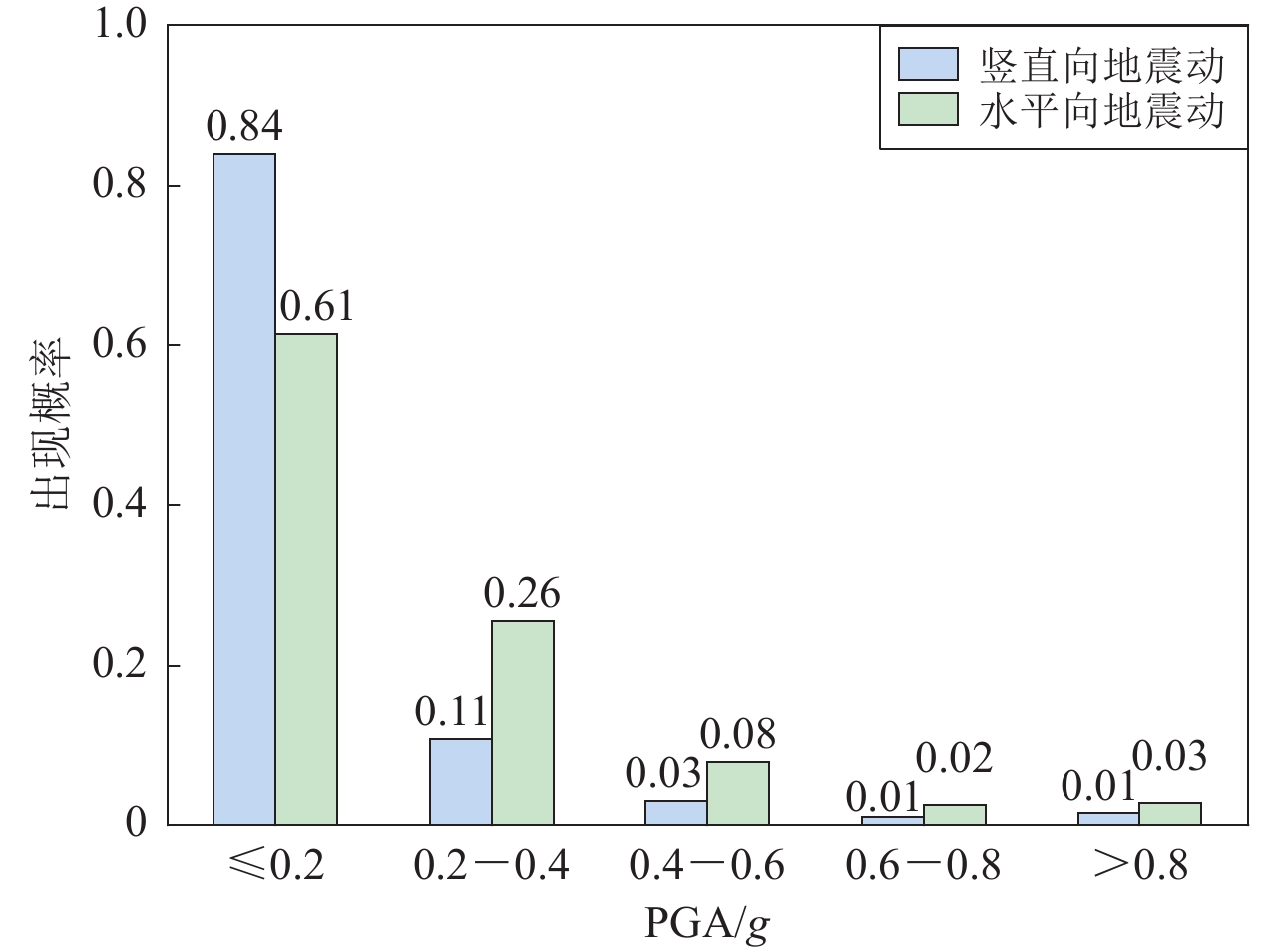
 下载:
下载:
